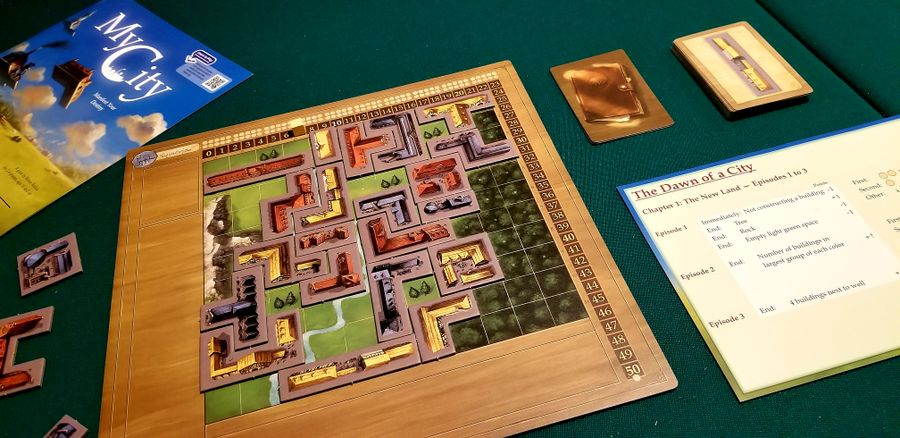
Welcome back to Tabletop Tastes: My favorite flavors in board games! This is a series where we spend each episode diving deep into an essential element of game design. For hobbyist gamers, this series will help you to explore your own tastes in the hobby and perhaps discover your next favorite game that fits those tastes. For game designers, this series will offer you more tools to add to your utility belt and metrics to measure your projects by. If you missed the previous episode, then go on and check out Tabletop Tastes #8: Fresh Downtime.
We’ve all had the experience of walking into a unique restaurant for the first time and instantly thinking to ourselves, “This was a mistake.” Or perhaps that thought didn’t hit you until the food you ordered was placed in front of you and you got your first real look at the chef’s questionable handiwork. Either way, these feelings of regret usually accompany a poor first impression from the building’s tidiness or the presentation of the food. For me, the rest of the meal is usually a depressing and uncomfortable affair as I think about all the other delightful meals at better restaurants that my wasted money could have gone towards.

Sometimes, even an elaborate home-cooked feast can bring feelings of regret when it leaves you with a too-messy kitchen and merely an ok meal. Sadly, the ease of meal preparation and cleanup is often the number one factor that determines what we choose to eat. I wish it wasn’t so, but the same is true for what we choose to play.
Trapped in the Labyrinth of Catacombs
Catacombs (Third Edition) is an epic dungeon-crawling dexterity game with a gorgeous presentation thanks to the talented efforts of Kwanchai Moriya. It’s also critically acclaimed enough to flaunt all of its recommendations across one entire side of its large box. The game has all the indications of a must-play in my book, which is why I was all the more shocked when we hated it.

For us, Catacombs is a design containing maximum work and minimal payoff. You’ll start off by placing dozens of stickers on various disks and reading hundreds of little rules in a large, complicated rulebook. Seriously, this game has as dense and lengthy of a rulebook as Great Western Trail. I’m by no means an expert in this area, but as a general rule I’d say that is NOT something to aspire to in a dexterity game!
If you still have enough energy to actually dive into Catacombs at this point, don’t get cozy, because you will be spending most of your time setting up and tearing down and digging through piles and rummaging through bags and re-referencing rules all in order to walk and stand and lean around your table for a few 5-minute sessions of flicking discs across a narrow board. Is this really worth all the time, energy, and effort?

With all of this excessive fiddliness, the game outstays its welcome by hours. We lasted a couple hours and finally threw in the towel. Aside from something like Monopoly years ago, Catacombs might be the only game that we just gave up on instead of finishing out. It’s one of the few acquisitions into my collection that quickly made me think, “This was a mistake.”
Perhaps in a different environment with an enthusiastic group, more energy, and a good teacher, we could have found ourselves having a blast with this ambitious design. But Catacombs’ main problem is that it exists in the same universe as Crokinole. In the same amount of time that is spent setting up, managing, and tearing down all the rooms in a single playthrough of Catacombs, I can play dozens of rounds of the beautifully elegant Crokinole.

Mechs vs. My Will to Carry On
I acquired a similar exhaustion of game management from the widely loved Mechs vs Minions. I’ll be honest, the presentation and bang-for-your-buck in this game are unbelievable. This box is ridiculously huge and you can’t help but grin every time you break it out and carry it to the table in a grand procession. Nevertheless, the exhaustion crept in after merely a few plays.

Every time we got Mechs vs Minions to the table, it took longer to set up, learn the new scenario, and tear down than it did to actually play a round. I couldn’t shake the feeling that this kind of experience is just more worthwhile as a video game where all of the extra management is taken care of by the software (I’ve never played League of Legends, but Into the Breach is a great example of a cleaner alternative).

For similar reasons, I’ve always avoided the legendary Gloomhaven with its endless pieces and sprawling components. That is, I avoided it until Mr. Childres played his trump card––the spiral-bound book of Gloomhaven: Jaws of the Lion. This enormous leap in convenience and accessibility is one of the reasons why I declared that Gloomhaven: Jaws of the Lion will be one of the most influential games of the decade. While Jaws of the Lion is no walk in the park to setup, teardown, and learn to play, the streamlining of this experience is what makes it satisfying and worthwhile.

A Legacy of Diminishing Returns
I’m not quite done with blaspheming the holy titles of boardgamedom yet, as we’ve yet to discuss Pandemic Legacy. My wife and I embarked down Season 1’s journey with adventure in our hearts and gusto in our step. The added story, challenges, and objectives of each session kept things fresh and interesting, as this was our first foray into a legacy-style game.

Yet something emerged after wading even deeper into the legacy pool. The game started to bog itself down with all the extra rules, components, setup, tear down, interruptions, etc. Like Catacombs and Mechs vs Minions, we were suddenly spending more time managing the game than actually playing it. After the honeymoon phase of this novel experience was over, we were left with a game that was far too cumbersome and a story that was not nearly captivating enough to see through to the end.
Fortunately, we didn’t give up on legacy games altogether, because we’ve since discovered some bangers. I’ve already mentioned Jaws of the Lion, but two others have proven to me that that it’s possible to have an evolving legacy system with a clean setup and teardown. At one end of the spectrum, you have My City which is a legacy game purely in mechanisms with a light sprinkling of theme (it is a Knizia after all). On the other end, you have The King’s Dilemma, which is a legacy game with elaborate stories, encouraged role-playing, and branching paths.
My City is a piece of cake to setup, manage, and teardown. In fact, it won the category of accessibility & elegance in the Battle of the Polyominoes despite it being the only design with a legacy system. Just dump out your bag of tiles, shuffle the cards, read the couple new paragraphs of rules or objectives, and go! At the end of the play, give the winner a couple legacy points, maybe put another sticker or two on your board, clear off your board and start a new round or toss the tiles in the box and call it a day!

The King’s Dilemma has also been refreshingly simple and consistent in its setup and teardown. Despite the many branching storylines that continue from one game to the next, this epic game has kept a light cadence and reliable rhythm that Pandemic Legacy Season 1 could only dream of. The important difference here is that the box insert is so well organized and the legacy management is unchanging from one round to the next that the game gets out of its own way and just lets the participants play.

Most importantly, the extra tasks, layers, and rules that we’ve seen in My City and The King’s Dilemma have all proven their worth as they’ve affected the gameplay and/or story in meaningful ways. With Pandemic Legacy Season 1, we had far too many occurrences of more fiddly fluff being forced upon us yet bearing little-to-no impact on the way we played and won the session.
The truth is that most of us only have time for games after a long shift at work. Half of the battle is getting ourselves motivated enough to sit down at the table and use our hands and brain rather than dissolving into a couch and streaming shows. The cleanliness of setup & teardown is one of the biggest factors in how frequently a game gets played or if any games get played at all.

At the end of the day, a kitchen explosion is only worthwhile if it results in an incredible meal (and ideally, plenty of leftovers). A restaurant’s cleanliness and presentation are typically good indicators of the quality of its food. And a design with a clean setup and teardown gives the game an immediate advantage in the work-to-payoff ratio. If the setup and teardown are going to be journeys in and of themselves, the gameplay better be able to justify it with something like a dynamic and satisfying arc.
Continue on to Tabletop Tastes #10: Dynamic Arc
More great games with a clean setup & teardown:
Effortless Setup/Teardown: Unmatched, Trophies, Railroad Ink, That’s Pretty Clever, Super Skill Pinball, Sprawlopolis, Skull, Parade, The Mind, On Tour, Love Letter, KLASK, Just One, High Society, For Sale, Blitzkrieg, Battle Line, Lost Cities
Designs that make Setup part of the Game: Through the Desert, Samurai, Sagrada, Roll for the Galaxy, Loot of Lima, Insider, Fort, Downforce, The Crew: The Quest for Planet Nine, Bus
Oddly Satisfying to Setup or Teardown: Patchwork, New York Zoo, PARKS, Onitama, Men at Work, Cryptid, The Estates, Dragon Castle, Dice Throne, Camel Up, Azul
Beefy but Well-Earned Setup/Teardown: A Feast for Odin, Great Western Trail, Brass: Birmingham, Pipeline
What are your favorite games with a clean setup/teardown?

Article written by Nick Murray. To follow his designs as they come to fruition, subscribe to our newsletter and follow Bitewing Games on social media!



